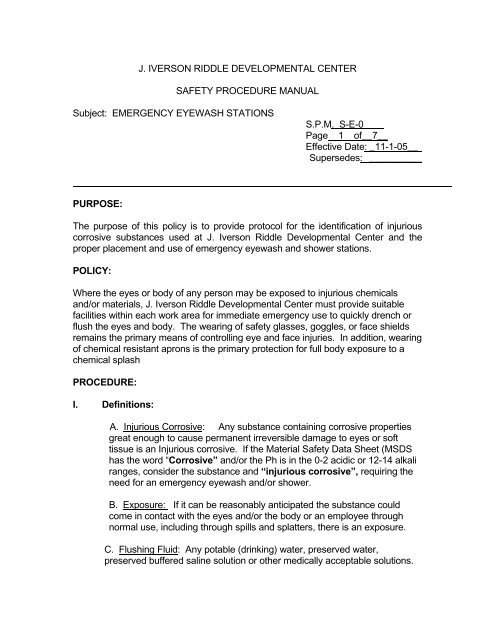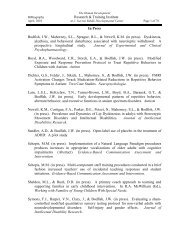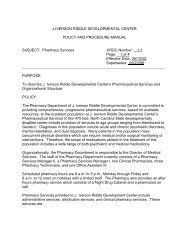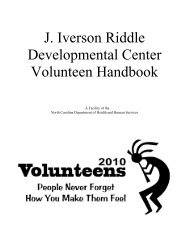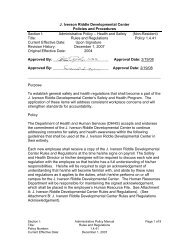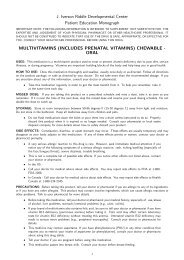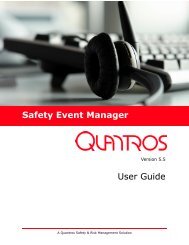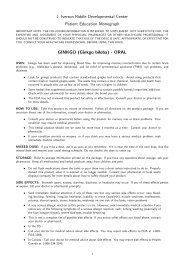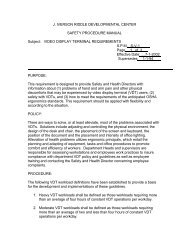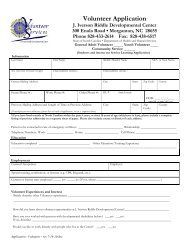S-E-0 Emergency Eye Wash Stations
S-E-0 Emergency Eye Wash Stations
S-E-0 Emergency Eye Wash Stations
You also want an ePaper? Increase the reach of your titles
YUMPU automatically turns print PDFs into web optimized ePapers that Google loves.
J. IVERSON RIDDLE DEVELOPMENTAL CENTER<br />
SAFETY PROCEDURE MANUAL<br />
Subject: EMERGENCY EYEWASH STATIONS<br />
S.P.M. S-E-0__<br />
Page 1 of__7__<br />
Effective Date: _11-1-05__<br />
Supersedes: __________<br />
PURPOSE:<br />
The purpose of this policy is to provide protocol for the identification of injurious<br />
corrosive substances used at J. Iverson Riddle Developmental Center and the<br />
proper placement and use of emergency eyewash and shower stations.<br />
POLICY:<br />
Where the eyes or body of any person may be exposed to injurious chemicals<br />
and/or materials, J. Iverson Riddle Developmental Center must provide suitable<br />
facilities within each work area for immediate emergency use to quickly drench or<br />
flush the eyes and body. The wearing of safety glasses, goggles, or face shields<br />
remains the primary means of controlling eye and face injuries. In addition, wearing<br />
of chemical resistant aprons is the primary protection for full body exposure to a<br />
chemical splash<br />
PROCEDURE:<br />
I. Definitions:<br />
A. Injurious Corrosive: Any substance containing corrosive properties<br />
great enough to cause permanent irreversible damage to eyes or soft<br />
tissue is an Injurious corrosive. If the Material Safety Data Sheet (MSDS<br />
has the word “Corrosive” and/or the Ph is in the 0-2 acidic or 12-14 alkali<br />
ranges, consider the substance and “injurious corrosive”, requiring the<br />
need for an emergency eyewash and/or shower.<br />
B. Exposure: If it can be reasonably anticipated the substance could<br />
come in contact with the eyes and/or the body or an employee through<br />
normal use, including through spills and splatters, there is an exposure.<br />
C. Flushing Fluid: Any potable (drinking) water, preserved water,<br />
preserved buffered saline solution or other medically acceptable solutions.
J. IVERSON RIDDLE DEVELOPMENTAL CENTER<br />
SAFETY PROCEDURE MANUAL<br />
Subject: EMERGENCY EYEWASH STATIONS<br />
S.P.M. _S-E-0___<br />
Page 2 of__7__<br />
Effective Date: _11-1-05__<br />
Supersedes: __________<br />
D. Personal <strong>Eye</strong>wash Equipment: These include all squeeze bottles,<br />
neutralizing solutions and portable water containers with limited capacity.<br />
These are designed to provide immediate flushing fluid. They shall only be<br />
used as temporary care until an emergency eyewash station can be<br />
reached.<br />
E. <strong>Emergency</strong> <strong>Eye</strong>wash Station: A continuous flow station capable of<br />
providing a minimum of 15 minutes of eye of body flushing.<br />
II. DESIGN REQUIREMENTS:<br />
A. <strong>Emergency</strong> <strong>Eye</strong>wash Station: Minimum requirements for eyewash<br />
stations are met by use of:<br />
1. Fixed commercially available apparatus designed specifically for<br />
eyewash or an apparatus of similar design an equal efficiency<br />
constructed by the employee.<br />
2. A hose of adequate length and flexibility to allow the user to<br />
direct a flow of water into the eyes. A pressure-reducing,<br />
divergent flow or “spent stream” nozzle and quick opening<br />
valve, providing full o /full off control with one hand operation<br />
located at the nozzle must be attached to the hose. It is<br />
recommended the nozzle be mounted at a height between 33<br />
and 45 inches.<br />
3. The emergency shower should deliver a pattern of water with a<br />
diameter of water at least 20 inches at 60 inches above the floor.<br />
The showerhead should be between 82-96 inches from the floor<br />
and deliver a minimum volume of spray of 20 gallon/minute for a<br />
minimum time of 15 minutes.
J. IVERSON RIDDLE DEVELOPMENTAL CENTER<br />
SAFETY PROCEDURE MANUAL<br />
Subject: EMERGENCY EYEWASH STATIONS<br />
S.P.M. _S-E-0___<br />
Page 3 of_7___<br />
Effective Date: _11-1-05__<br />
Supersedes: __________<br />
III. LOCATION AND SIGNAGE:<br />
A. All required eyewash and shower facilities shall be located within a<br />
distance from the point of a hazardous exposure which can be<br />
negotiated in 10 seconds or less, but in no case more than 75 feet.<br />
B. When placed in an area where highly corrosive chemicals are used, the<br />
eyewash and/or shower shall be placed within 10 feet of the point of<br />
a hazardous exposure and in such a fashion that the apparatus does<br />
not become contaminated from the chemicals.<br />
C. If possible, the eyewash and/or shower should not be separated by a<br />
wall or partition from the hazardous work area. (See Section IV for<br />
exemptions).<br />
D. <strong>Eye</strong>wash and shower apparatus shall be located on the same floor as<br />
the hazardous work area.<br />
E. <strong>Eye</strong>wash and shower apparatus shall be protected from freezing when<br />
installed outdoors.<br />
F. There should be a drainage system, which captures the excess water.<br />
G. The location of each emergency eyewash and shower station shall be<br />
Identified with highly visible sign. The sign shall be in the form of a<br />
symbol that does not require workers to have language skills to<br />
understand it.<br />
H. A minimum of 36” (3 feet) diameter area shall remain free of<br />
obstruction surrounding the equipment.
J. IVERSON RIDDLE DEVELOPMENTAL CENTER<br />
SAFETY PROCEDURE MANUAL<br />
Subject: EMERGENCY EYEWASH STATIONS<br />
S.P.M. S-E-0__<br />
Page 4 of_7___<br />
Effective Date: _11-1-05__<br />
Supersedes: __________<br />
IV.<br />
RESIDENT CARE AREAS:<br />
<strong>Emergency</strong> eyewash stations may be placed behind locked doors in resident care<br />
areas provide the following steps are in place.<br />
1. Staff are always present and immediately available to assist in an<br />
injured employee.<br />
2. All working staff have a key on their person that fits the door lock<br />
for the room housing the eyewash station.<br />
3. All staff in area receive training regarding their responsibility to<br />
assist the injured staff and the correct steps to assist them<br />
V. TEMPERATURE:<br />
A. The temperature of the water used in emergency eyewash and shower<br />
B. facilities shall not exceed the extremes of freezing and 110 degrees<br />
Fahrenheit.<br />
A. Water temperatures should be maintained at a comfortable range of 60-<br />
95 degrees Fahrenheit.<br />
VI.<br />
INSPECTIONS:<br />
Each emergency eyewash station must receive a general weekly inspection<br />
by the department head/supervisor or his/her designee as<br />
outlined on the <strong>Emergency</strong> <strong>Eye</strong>wash Inspection Guide. (See Attachment A).<br />
The inspection shall be recorded on the <strong>Emergency</strong> <strong>Eye</strong>wash station Inspection<br />
Form. (See Attachment B) Inspection forms must be maintained in the area<br />
for review upon request.
J. IVERSON RIDDLE DEVELOPMENTAL CENTER<br />
SAFETY PROCEDURE MANUAL<br />
Subject: EMERGENCY EYEWASH STATIONS<br />
S.P.M. S-E-0___<br />
Page 5 of__7__<br />
Effective Date: _11-1-05__<br />
Supersedes: __________<br />
WEEKLY INSPECTION:<br />
1. Check to ensure access to the station is clear and unobstructed.<br />
2. Check to ensure caps are present on the station.<br />
3. Activate the emergency eyewash station.<br />
a. Turn the equipment to full flow for at least 3 minutes.<br />
b. Check to ensure there is full flow and no obstruction.<br />
c. Check to ensure there is no residue or water discoloration.<br />
d. Check to ensure the water temperature is not greater than 110<br />
degrees by using a pocket thermometer.<br />
4. Clean the caps of the station with a disinfectant.<br />
5. Clean Basin<br />
6. Check caps for cracks or broken parts.<br />
7. Turn the equipment to the off position.<br />
8. Document inspection on the <strong>Emergency</strong> <strong>Eye</strong>wash Inspection Form.<br />
If the station is not working properly and/or has missing parts the person completing<br />
the inspection shall contact the Safety and Health Director immediately for repair.<br />
The Safety and Health Director will be responsible for completing the work order for<br />
all needed repairs.
J. IVERSON RIDDLE DEVELOPMENTAL CENTER<br />
SAFETY PROCEDURE MANUAL<br />
Subject: EMERGENCY EYEWASH STATIONS<br />
S.P.M. _S-E-0__<br />
Page 6 of__7__<br />
Effective Date: _11-1-05__<br />
Supersedes: __________<br />
‘<br />
SIX MONTH INSPECTION:<br />
The Safety and Health Director will be responsible for completing a more<br />
comprehensive inspection each six (6) months. The inspection shall include but not<br />
limited to:<br />
1. Conduct all aspects of weekly inspection.<br />
2. Check for any corrosive buildup in or around the point of flow.<br />
3. Check for visible leaks in the plumbing of the station<br />
4. Check for ease of operation, making certain all parts work without problems.<br />
5. Document inspection on <strong>Emergency</strong> <strong>Eye</strong>wash station Inspection form.<br />
Employee Training:<br />
The Safety and Health Director shall develop training and provide it to<br />
department heads/supervisors in areas where <strong>Emergency</strong> <strong>Eye</strong>wash <strong>Stations</strong> are<br />
located.<br />
The training shall include:<br />
• A plan outlining the objectives, steps, methods of the training and a method<br />
to test trainee.<br />
• The method by which training will be provided to employees.<br />
training shall be provided to each employee upon initial employment and/or<br />
when changes in procedure or changes in work practices
J. IVERSON RIDDLE DEVELOPMENTAL CENTER<br />
SAFETY PROCEDURE MANUAL<br />
Subject: EMERGENCY EYEWASH STATIONS<br />
S.P.M. _S-E-0__<br />
Page 7 of__7__<br />
Effective Date: _11-1-05__<br />
Supersedes: __________<br />
‘<br />
Department heads/supervisors will be responsible for the training of new<br />
employees on their first day of employment and/or prior to participating in a<br />
situation where they have a possible exposure to injurious corrosive materials.<br />
Training shall include but not limited to:<br />
• Location of and where to locate information to how long to flush skin/eyes<br />
when exposed to a specific chemical.<br />
• Location of and proper use of <strong>Emergency</strong> <strong>Eye</strong>wash station.<br />
Refresher training will be conducted annually by the department head/supervisor<br />
when it is determined the employee needs a refresher update.<br />
Documentation of training shall be completed on the J. Iverson Riddle<br />
Developmental Center Training Roster and be maintained by the department<br />
head/supervisor for review upon request for at least 2 years.<br />
______________________________ __________________________<br />
J. Iverson Riddle, MD David L. Wise<br />
Facility Director<br />
Safety and Health Director<br />
_____________________<br />
Date<br />
_____________________<br />
Date


